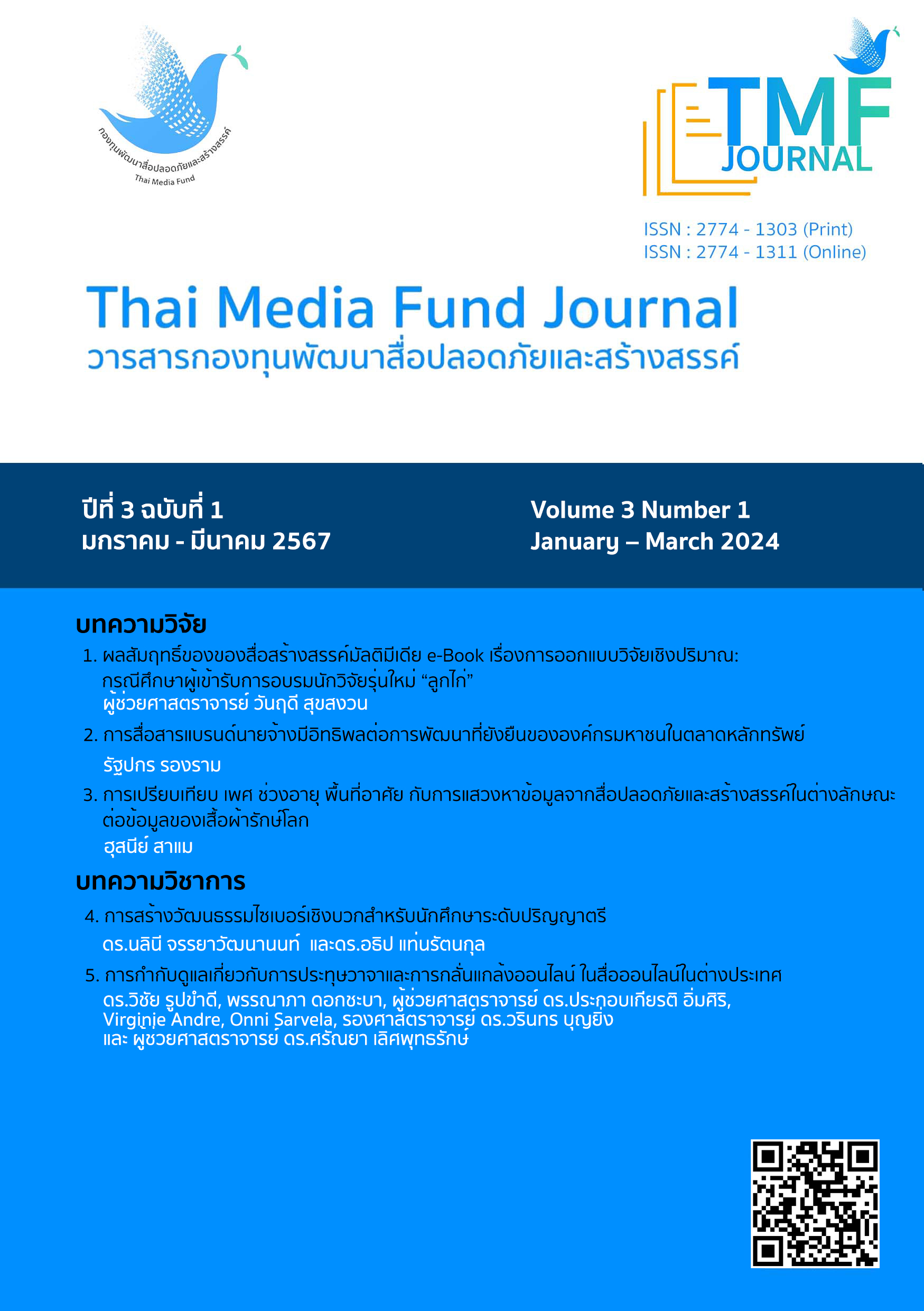ผลสัมฤทธิ์ของของสื่อสร้างสรรค์มัลติมีเดีย e-Book เรื่องการออกแบบวิจัยเชิงปริมาณ: กรณีศึกษาผู้เข้ารับการอบรม นักวิจัยรุ่นใหม่ “ลูกไก่”
Main Article Content
บทคัดย่อ
บทคัดย่อ
งานวิจัยนี้ได้นำสื่อสร้างสรรค์มัลติมีเดีย ในรูปของ e-Book เรื่องการออกแบบวิจัยเชิงปริมาณ มาให้ผู้เข้าอบรมในหลักสูตรสร้างนักวิจัยรุ่นใหม่” (ลูกไก่) จำนวน 50 คน ได้ศึกษาด้วยตนเอง และทำการทดสอบก่อนเรียนและหลังเรียน โดยมีวัตถุประสงค์ ในการประเมินผลสัมฤทธิ์ และความพึงพอใจของผู้เข้าอบรมที่มีต่อ e-Book ที่ผู้วิจัยได้พัฒนาขึ้น เครื่องมือที่ใช้ในการวิจัย ได้แก่ e-Book แบบทดสอบก่อนเรียน หลังเรียน และแบบประเมินความพึงพอใจ สถิติที่ใช้ในการวิจัย คือ สถิติเชิงบรรยาย ได้แก่ ค่าเฉลี่ย ส่วนเบี่ยงเบนมาตรฐาน และสถิติเชิงสรุปอ้างอิง ได้แก่ dependent paired samples t test ผลการวิจัยพบว่า 1) คะแนนเฉลี่ยก่อน และหลังเรียน เท่ากับร้อยละ 29.4 และ 87 ผลการเรียนรู้เพิ่มขึ้น มีความแตกต่างกันอย่างมีนัยสำคัญทางสถิติ 0.05 2) ประสิทธิภาพของสื่อสร้างสรรค์มัลติมีเดีย e-Book เรื่องการออกแบบวิจัยเชิงปริมาณ
มีประสิทธิภาพ ตามเกณฑ์ 80 โดยมีคะแนนทดสอบหลังเรียนเรียน ร้อยละ 87 ซึ่งถือว่าอยู่ในเกณฑ์ดี และ 3) มีคะแนนความพึงพอใจโดยรวมเท่ากับ 4.0 อยู่ในระดับมาก สรุปว่าสื่อสร้างสรรค์มัลติมีเดีย e-Book เรื่องการออกแบบวิจัยเชิงปริมาณ มีความเป็นไปได้มากที่จะใช้เพื่อเพิ่มความสนใจในการเรียนรู้
Article Details

อนุญาตภายใต้เงื่อนไข Creative Commons Attribution-NonCommercial-NoDerivatives 4.0 International License.
เอกสารอ้างอิง
เอกสารอ้างอิง
Cho, E., & Kim, S. (2015). Cronbach’s coefficient alpha: Well known but poorly understood. Organizational Research Methods, 18(2), 207-230. Retrieved from https://doi.org/10.1177/1094428114555994
Chailapo, P., & Khanjananopinit, S. (2022). The results of blended teaching and learn management by using learning management system and application for online studying that is applicable for self-directed learning skills and academic achievement of the 4th year cadets learning military administrative psychology course (PC 4103). Royal. Thai Naval Academic Journal of Social Sciences, Humanities and Education, 9(1), 67-78.
Cohen, J. (1998). Statistical power analysis for the behavioral sciences (2nd ed.). Hillsdale, NJ: Lawrence Erlbaum Associates.
Chotkunakitti, P., Suksanguan, W., & Treammeerit, N. (2023). The development of electronics comic book on research design topic. Journal of MCU Nakhondhat, 10(2), 240.
Dale, E. (1969). Audiovisual method in teaching (3rd ed). New York: Holt Rinehart and Winston.
Faul, F., Erdfelder, E., Lang, A.-G., & Buchner, A. (2007). G*Power 3: A flexible statistical power analysis program for the social, behavioral, and biomedical sciences. Behavior Research Methods, 39, 175-191.
Faza, W. M., & Rahayu, Y. S. (2023). The development of e-book based on a scientific approach to train critical thinking ability on the structure and function of plant tissue topic. Bio Edu, 12(3), 773-786.
Glawthanong, J., & SapphakitJumnong, K. (2022). Comparison of academic achievement on mathematics, subject: teaching multiplication of the 2nd grade students by using mixed media series ‘fun multiplication’ and using normal teaching method. Journal of Roi Kaensarn Academi, 7(4), 362-373.
Meechai, C. et al. (2022). The development of the teaching set for the special topic course on educational innovation by using blended learning technique. Academic Journal Public and Private Management, 4(2), 24-32.
Phethirunpong, P., & Wajjana, A. (2021). The study of academic achievement on solar system and satellite by using blended learning management, together with electronic books of the10th grade students. Journal of Roi Kaensarn Academi ,7(1).
Promwong, C. (2013). Testing the effectiveness of teaching media. Silpakorn Journal Educational Research, 5(1), 8.
Rahmaniyah, A., Hanifah, N., & Sunaengsih,C. (2023). Development of the e-book “knowing history around us” to increase interest in learninghistory in elementary school. Journal Cakrawala Pendas, 9(1), 40-51.
Safitri, A., Anas, N., & Khairuna, B. (2023). Development of biology e-book teaching materials based on local potential in asahan district on ecosystem materials for class x sma/ ma students at smanegeri 1 pulau rakya. International Journal of Educational Review, Law And Social Science, 3(5), 1629.
Saiyot, L., & Saiyot, A. (1985). Principles of educational research. Suksaporn.
Suksanguan, W., Chotkunakitti, P., & Tripattanasit, P. (2023). Developing and testing the efficiency of smart books in the AI: Artificial Intelligence era for blended learning in the course of management accounting on Decision making. Journal of Arts Management, 7(4), 1592.
Schüler, A., Scheiter, K., & Gerjets, P. (2013). Is spoken text always better? Investigating the modality and redundancy effect with longer text presentation. Computers in Human Behavior, 29(4), 1590-1601.
Srithongkul, W. (2022). Blended media electronic book development on English for learning skill of the students of Thonburi Rajabhat University, Samut Prakan. Academic Journal of Srisaket Rajabhat University, 16(1), 89-99.
Thanapatthameemanee, H. (2018). Blended learning management by the lessons on internet, subject: Using Microsoft Excel 2010 for The 7th grade students. Journal of Educational Technology and Communications Faculty of Education Mahasarakham University, 1(1), 54.


